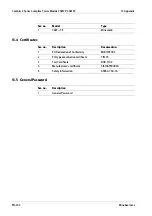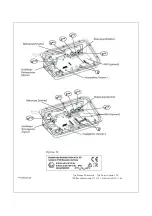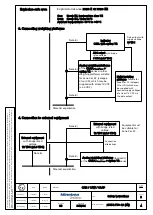
Scale
---
CAIS / CAW / CAAP
Revision
03
Released by
Reviewed by
Written by
1/8/2021
1/8/2021
1/6/2021
Date
T. Hiller
T. Hiller
Name
Material
Title
Alteration
543604
Drawing number
Safety instructions
65954-750-16 (EN)
Sheet
3
R. Koch
of
4
Th
e
co
py
in
g,
d
ist
rib
ut
io
n
an
d
ut
iliz
at
io
n
of
th
is
do
cu
m
en
t a
s
w
el
l a
s
th
e
co
m
m
un
ica
tio
n
of
it
s
co
nt
en
ts
to
o
th
er
s
w
ith
ou
t e
xp
re
ss
ed
a
ut
ho
riz
at
io
n
is
pr
oh
ib
ite
d.
O
ffe
nd
er
s
w
ill
be
h
el
d
lia
bl
e
fo
r t
he
p
ay
m
en
t o
f d
am
ag
es
. A
ll
rig
ht
s
re
se
rv
ed
in
th
e
ev
en
t o
f t
he
gr
an
t o
f a
p
at
en
t,
ut
ilit
y
m
od
el
o
r o
rn
am
en
ta
l
de
sig
n
re
gi
st
ra
tio
n.
A
ny
in
fo
rm
at
io
n
in
th
is
do
cu
m
en
t i
s
su
bj
ec
t t
o
ch
an
ge
w
ith
ou
t n
ot
ice
a
nd
d
oe
s
no
t r
ep
re
se
nt
a
c
om
m
itm
en
t o
n
th
e
pa
rt
of
M
in
eb
ea
In
te
c
un
le
ss
le
ga
lly
p
re
sc
ib
ed
.
These safety instructions apply to installation, use, maintenance, and repair
1.
The equipment (indicator CAIS., weighing platform CAAP..-……-……, complete scale CAW…-……-…...) is suitable
for use in explosion-risk areas of zone 2 (group IIC, temperature class T4 / T6 for the weighing platform) and
zone 22 (group IIIC; surface temperature 80°C) as per EU Directive 2014/34/EU and the associated
harmonized European standards. Compliance with other properties and requirements is therefore not
guaranteed.
2.
The equipment may only be used indoors.
3.
The equipment is not to be used as portable equipment.
4.
Installation, operation, maintenance, and repairs should only be performed by an authorized specialist, in
accordance with applicable laws, rules and regulations, ordinances, and standards. In particular, within the
scope of validity of EU Directive 2014/34/EU, standard EN 60079-14 must be observed for installation. Only
when the equipment and connected equipment are disconnected from all power sources may installation,
maintenance, cleaning, and repair work take place.
5.
The information on installation, operation, maintenance and repair given in the operating instructions supplied
with the equipment (including those for connected equipment) must be observed. The temperature ranges for
the connected equipment must also be observed.
6.
Only use the equipment in a temperature range of -10°C ... +40°C, do not expose to unauthorized sources of
heat or cold, direct sunlight, UV radiation, or strong jolts or vibrations and install so that heat can be sufficiently
dissipated on all sides and external heat sources are located far enough away.
7.
The cable glands for the data cables must be tightened with a torque of 5 Nm. The cable gland for the
network cable must be tightened with a torque of 2.5 Nm “cap” and 1.5 Nm “body”. Attach external
connection cables securely to avoid damage and tensile loading. The cable connections inside the explosion-
risk area must be secured against loosening.
8.
All metal parts must be galvanically connected to the same potential equalization so that any electrostatic
charges can be conducted away from the equipment. For this purpose, the operator is obligated to connect a
conductor with a gauge of at least 4 mm² (cross section) to the potential equalization connection (indicated by
the ground symbol) located on the housing. A suitable eyelet must be applied to the end of the cable. The
cable must be laid so that the ground connection cannot become loose. During installation and at regular
intervals, check if this connection to the equipotential bonding conductor is of low resistance. The indicator and
weighing platform must be connected separately to the equipotential bonding when no metallic connection
(e.g. a column) is used between them. Do not use the screen of the connection cable for equipotential
bonding.
9.
Before opening the equipment, switch off the supply voltage, or make sure that the area is not potentially
explosive. Do not connect or disconnect any live cables inside an explosion-risk area.
10.
When closing, tighten the cover screws securely.
11.
During initial startup the area must not be potentially explosive.
12.
The data cables to the connected equipment and the connection line to the weighing platform are classed as
flammable electrical circuits and must be protected against involuntary disconnection and may only be
connected and disconnected when the equipment is switched off. Block unused outputs to guarantee the IP65
level of protection. Keep any voltage transients away from the equipment.
13.
Data cables are only intended for data transfer and must not contain any supply voltage from the connected
equipment to the indicator / to the complete scale. A digital weighing platform that is permissible for zone 2 or
22 and connected to the data output may, however, be supplied with direct current if it can be supplied with
direct current of at least 16 VDC via the data output.







































